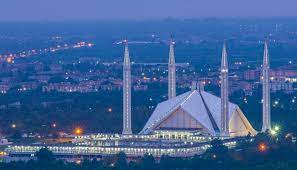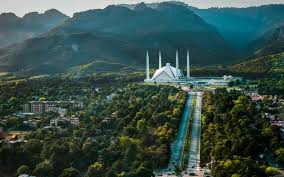History of Faisal Mosque
The Faisal Mosque is the biggest mosque in Pakistan, situated in the public capital city of Islamabad. Finished in 1986, it was planned by Turkish designer Vedat Dalokay, formed like a desert Bedouin's tent, is a notable image of Islamabad all through the world.
It is arranged at the north finish of Faisal Avenue, putting it at the northernmost finish of the city and at the foot of Margalla Hills, the westernmost lower regions of the Himalayas. It is situated on a raised space of land against a beautiful setting of the Margalla Hills. This advantageous area addresses the mosque's extraordinary significance and permits it to be seen from miles around day and night.
The Faisal Mosque was considered as the National Mosque of Pakistan and named after the late King Faisal receptacle Abdul-Aziz of Saudi Arabia, who upheld and financed the venture.
The biggest mosque in Pakistan, the Faisal Mosque was the biggest mosque on the planet from 1986 until 1993, when it was overwhelmed in size by the recently finished Hassan II Mosque in Casablanca, Morocco. Ensuing extensions of the Masjid al-Haram (Grand Mosque) of Mecca and the Al-Masjid al-Nabawi (Prophet's Mosque) in Medina, Saudi Arabia, during the 1990s consigned Faisal Mosque to fourth place as far as size.
The stimulus for the mosque started in 1966 when King Faisal receptacle Abdul-Aziz upheld the drive of the Pakistani Government to assemble a public mosque in Islamabad during an authority visit to Pakistan.
In 1969, a global contest was held in which engineers from 17 nations offered 43 proposition. The triumphant plan was that of Turkish modeler Vedat Dalokay.[3]Construction of the mosque started in 1976 by National Construction of Pakistan, driven by Azim Khan and was financed by the public authority of Saudi Arabia, at an expense of more than 130 millionSaudi riyals (roughly 120 million USD today). Lord Faisal receptacle Abdul Aziz was instrumental in the financing, and both the mosque and the street prompting it were named after him after his death in 1975. The mosque was finished in 1986, and used to house the International Islamic University. Numerous moderate Muslims reprimanded the plan at first for its offbeat plan and absence of a customary arch design, however most analysis finished when the finished mosque's scale, structure, and setting against the Margalla Hills became obvious.
The Faisal Mosque is crafted by Turkish designer Vedat Dalokay, who won the Aga Khan Award for Architecture for the venture. The mosque's design is current and extraordinary, lacking both the customary vaults and curves of most different mosques all throughout the planet.
Shah Faisal Masjid, otherwise called Faisal Mosque, situated in the beginning of Margala slope area E-7 Islamabad Pakistan
The mosque's strange plan is a takeoff from the long history of South Asian Islamic engineering, combining contemporary lines with the more conventional look of an Arab Bedouin's tent, with its enormous three-sided supplication lobby and four minarets. Notwithstanding, dissimilar to conventional masjid plan, it comes up short on an arch. The minarets get their plan from Turkish practice and are slight and pencil like.
The state of the Faisal Mosque is an eight-sided substantial shell roused by a desert Beduoin's tent and the cubic Kaaba in Mecca, flanked by four strange minarets motivated by Turkish design. The engineer later disclosed his intuition to configuration school understudies:
" I attempted to catch the soul, extent and math of Kaaba in a simply conceptual way. Envision the summit of every one of the four minaret as a scaled blast of four most noteworthy corners of Kaaba – hence a concealed Kaaba structure is limited by the minarets at the four corners in an extent of tallness to base. Shah Faisal Mosque similar to Kaaba.
Presently, on the off chance that you join the zenith of every minaret to the foundation of the minaret askew inverse to it correspondingly, a four-sided pyramid will be limited by these lines at the base side inside that imperceptible 3D shape. That lower level pyramid is treated as a strong body while four minarets with their pinnacle total the fanciful shape of Kaaba.
Passageway is from the east, where the supplication corridor is fronted by a patio with porticoes. The International Islamic University was housed under the principle patio, yet as of late migrated to another grounds. The mosque actually houses a library, auditorium, exhibition hall and bistro. The inside of the primary tent-formed corridor is shrouded in white marble and enlivened with mosaics and calligraphy by the popular Pakistani artistSadequain, and a fabulous Turkish-style light fixture. The mosaic example enhances the west divider, and has the kalimah written in earlyKufic script, rehashed in identical representation design.
Nekka Phullai is the nearby slope to the mosque in Margalla Hills.
To Read More Blogs Check This :




No comments:
Post a Comment